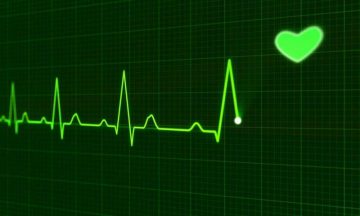- Home
- Editorial
- News
- Practice Guidelines
- Anesthesiology Guidelines
- Cancer Guidelines
- Cardiac Sciences Guidelines
- Critical Care Guidelines
- Dentistry Guidelines
- Dermatology Guidelines
- Diabetes and Endo Guidelines
- Diagnostics Guidelines
- ENT Guidelines
- Featured Practice Guidelines
- Gastroenterology Guidelines
- Geriatrics Guidelines
- Medicine Guidelines
- Nephrology Guidelines
- Neurosciences Guidelines
- Obs and Gynae Guidelines
- Ophthalmology Guidelines
- Orthopaedics Guidelines
- Paediatrics Guidelines
- Psychiatry Guidelines
- Pulmonology Guidelines
- Radiology Guidelines
- Surgery Guidelines
- Urology Guidelines
Novel mechanism underlying efficacy of common heart failure drug identified

Beta-blocker drugs serve a key role in the treatment of heart failure, preventing bombardment of the heart by catecholamines -- substances like epinephrine and norepinephrine -- which overexcite and stress the heart. But not all heart failure patients respond to beta-blockers, for reasons that have been unclear. Now, in new work, researchers at the Lewis Katz School of Medicine at Temple University (LKSOM) show that dysfunction of beta-adrenergic receptor 3 (β3AR) -- a novel beta-blocker target -- and consequent decreases in a critical cardioprotective phospholipid may be to blame.
The cardioprotective molecule, known as sphingosine 1-phosphate 1 (S1P), keeps heart cells from dying following events such as heart attack and heart failure. "The higher the levels of S1P in heart failure, the better the outcome," explains Walter J. Koch, PhD, W.W. Smith Endowed Chair in Cardiovascular Medicine, Professor and Chair of the Department of Pharmacology and Director of the Center for Translational Medicine at LKSOM, as well as senior investigator on the new study.
According to Dr. Koch, beta-blocker drugs increase S1P levels by attenuating hyperactive beta-adrenergic receptor signaling, with most of the drugs acting selectively on β1ARs. "But the drugs can also have stimulatory effects on β3AR, promoting β3AR activity," he says. "Our new work shows that when β3AR is dysfunctional, the protective effects of S1P are lost."
The findings were published online July 3 in the Journal of the American College of Cardiology.
"Our group has spent more than a decade investigating beta-blocker mechanisms," explains Alessandro Cannavo, PhD, a research associate in the Center for Translational Medicine and Department of Pharmacology at LKSOM and lead author on the new report. "We know that a kinase called GRK2 that is downstream of beta-adrenergic receptor activation is responsible for downregulation (decreased production) of the S1P receptor 1 (S1PR1), which functions in cardioprotective signaling. We have also demonstrated in rats that restoration of S1PR1, via gene-therapy, can correct heart failure."
In their new study, Dr. Koch and colleagues looked more deeply into the mechanisms driving S1PR1 downregulation in heart failure, as well as the effects on S1P of metoprolol, a commonly used beta-blocker drug. Experiments in cells exposed to isoproterenol (to mimic the condition of heart failure) showed that treatment with metoprolol prevented S1PR1 downregulation. Microscopic studies revealed that whereas isoproterenol triggered S1PR1 internalization, with receptors retreating from their active front at the cell surface into the interior of the cell, metoprolol produced the opposite effect.
The researchers further showed in mice that treatment with either metoprolol or S1P effectively halts heart failure progression following heart attack. To determine whether those effects were related to β3AR, Dr. Koch's team performed a series of experiments in β3AR knockout mice. S1P levels remained low in β3AR knockout animals, despite treatment with metoprolol. Moreover, in the absence of β3AR, metoprolol failed to ameliorate cardiac damage suffered post-heart attack, whereas metoprolol improved cardiac function after heart attack in mice with normal β3AR expression.
Analyses of samples from heart failure patients taking β1AR blockers confirmed the clinical relevance of the findings. Compared to untreated patients, circulating levels of S1P were significantly elevated in patients that had been treated with the drugs.
"In the concept of precision medicine, our study suggests that altered β3AR or S1P signaling can be responsible for the diverse response to beta-blockers between human patients usually observed in clinical practice," says Dr. Cannavo.
"Mechanistically, we've identified a novel means by which β1AR blockers prevent the progression of heart failure, whereby β3AR must be active for metoprolol to work," adds Dr. Koch.
The team plans next to explore the effects of beta-blockers that lack activity at β3AR.
For more details click on the link : Alessandro Cannavo, Giuseppe Rengo, Daniela Liccardo, Andres Pun, Ehre Gao, Alvin J. George, Giuseppina Gambino, Antonio Rapacciuolo, Dario Leosco, Borja Ibanez, Nicola Ferrara, Nazareno Paolocci, Walter J. Koch. β 1 -Blockade Prevents Post-Ischemic Myocardial Decompensation Via β 3 AR-Dependent Protective Sphingosine-1 Phosphate Signaling. Journal of the American College of Cardiology, 2017; 70 (2): 182 DOI: 10.1016/j.jacc.2017.05.020

Disclaimer: This site is primarily intended for healthcare professionals. Any content/information on this website does not replace the advice of medical and/or health professionals and should not be construed as medical/diagnostic advice/endorsement or prescription. Use of this site is subject to our terms of use, privacy policy, advertisement policy. © 2020 Minerva Medical Treatment Pvt Ltd